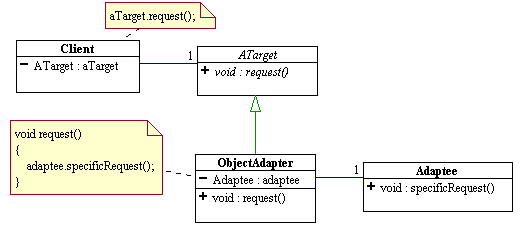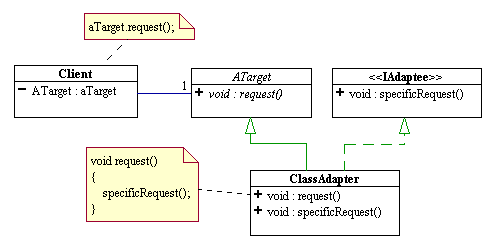Object Adapters
Object adapters use a compositional technique to adapt one interface to another. The adapter inherits the target interface that the client expects to see, while it holds an instance the adaptee. When the client calls the request() method on its target object (the adapter), the request is translated into the corresponding specific request on the adaptee. The target may be of an abstract class type (shown below) or of an interface type. In either case, the the forwarded request would be an overridden abstract method in the concrete adapter implementation.
 |
Object adapters enable the client and the adaptee to be completely decoupled from each other. Only the adapter knows about both of them.
Object Adapters Using Anonymous Inner Classes
One of the more common techniques for implementing object adapters in Java is to use anonymous inner classes. The technique is especially popular in creating adapters for Model-View-Controller (MVC) architecture implementations. For example, in the Controller of an MVC, the Model and the View objects need to be instantiated, each with adapters that connect to the other. By creating fields that hold references to the model and the view respectively, anonymous inner class implementations of the adapters can close over those fields (due to the lexical scoping properties of anonymous inner classes), thus enabling an adapter to reference its adaptee (model or view) without the need of an explicit field in the adapter itself.
Pseduo-code MVC implementation using anonymous inner class adapters
public class Controller {
private Model myModel;
private View myView;
public Controller() {
myModel = new Model( new IModel2ViewAdapter() {
public void request2View() {
myView.handleModelRequest(); // myView is in scope!
}
});
myView = new View( new IView2ModelAdapter() {
public void request2Model() {
myModel.handleViewRequest(); // myModel is in scope!
}
});
}
}
Because the anonymous inner class adapters close over the fields of the Controller, those fields are implicitly fields of the adapters and thus serve as the adapter's adaptees.
Notice how this technique neatly solves the problem of establishing two-way communications between two objects, without the need for "setter" method(s). The model and the view can be truly symmetrically decoupled.
